Having done more than a half-dozen coffee tours in Costa Rica, we must admit, Starbucks was low on our list. After all, with dozens of local farms and authentic experiences to be had, why would we choose to visit a corporate giant? But to our surprise, the tour exceeded our expectations and gave us a whole new appreciation for the Starbucks brand. In this post, we’ll share more about the Starbucks coffee tour in Costa Rica, why they won us over, and how you can plan a visit.
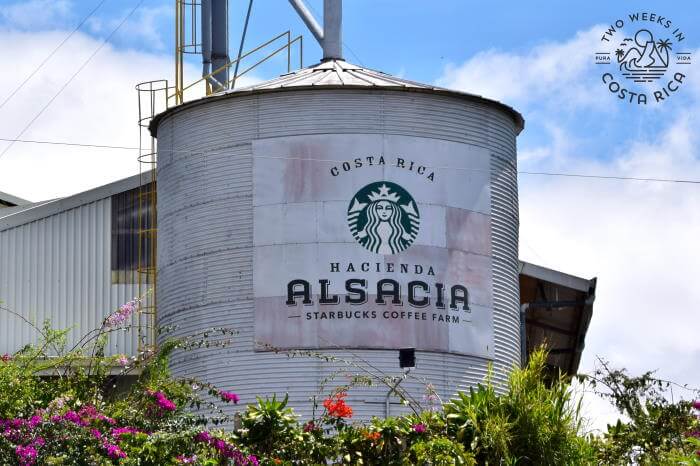
Background
Starbucks is the world’s largest coffeehouse chain. They have restaurants in 80 countries and more than 15,000 locations. Chances are you’ve been to one more than once (or maybe you go every day!).
Starbucks doesn’t typically grow its own coffee beans. Instead, they source them from different farms around the globe.
In Costa Rica and other countries, smaller coffee farmers bring their beans to market and sell them to the highest bidder. Starbucks buys a lot of beans and has a big interest in the quality and quantity that are available.
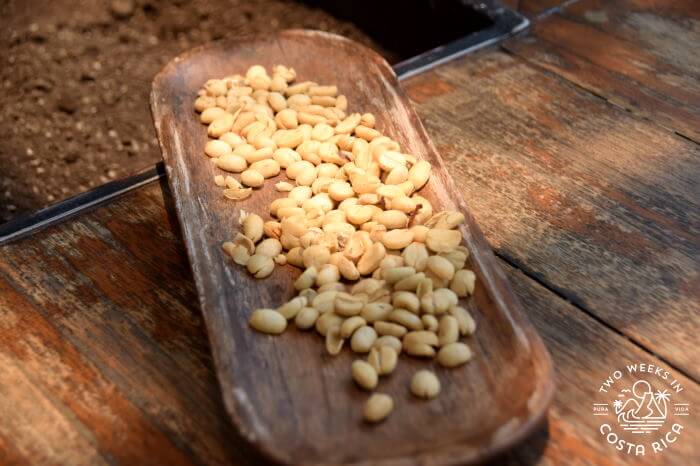
Unfortunately, coffee is not an indestructible crop. Environmental conditions like drought, heavy rains, and varying temperatures impact coffee production. Additionally, a leaf disease, called coffee rust can devastate a farm and is becoming more common.
Coffee Research at Hacienda Alsacia
Overview
As the Starbucks company grew, corporate leaders realized early on that the success of individual coffee farmers goes hand in hand with their own ambitions. They began doing global research and trainings to help farmers.
The first research center was formed in Costa Rica back in 2004.
Hacienda Alsacia Coffee Plantation
To take it a step further, in 2013 Starbucks purchased its first and only coffee plantation, Hacienda Alsacia near San Jose, Costa Rica.
At the time, yields at this 618-acre (250 hectare) farm were way down and it was struggling. Instead of pouring money into fixing it, the coffee giant decided to use its fields as a research lab.
Enlisting a team of agro-scientists and coffee specialists, the chain restored the farm’s health in just a few short years. Best of all, they used sustainable practices that any farmer, with almost any budget, could use. They have gone on to share these techniques openly, even with farmers that do not sell to Starbucks.
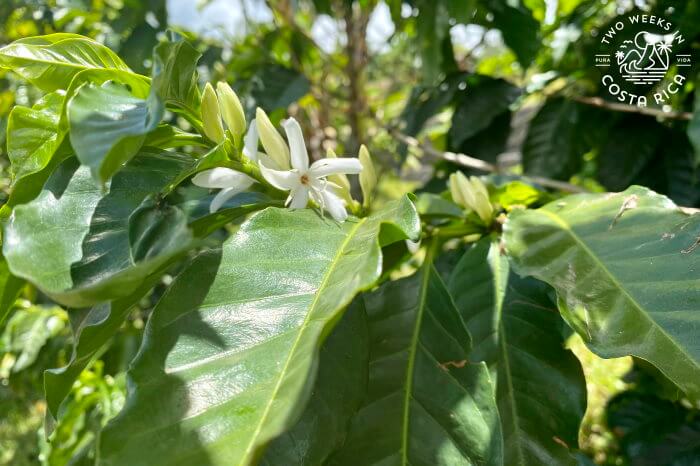
The researchers at Hacienda Alsacia have now moved on to testing new varieties. They crossbreed plants that have a high resistance with those that give the best tasting beans and have high production. Once they get the right mix, they share those new varieties with the global coffee community as well.
The Tour at Hacienda Alsacia
Location
The Starbucks Hacienda Alsacia plantation is located about an hour north of the capital of San Jose. It’s in a valley near Poas Volcano, a region with rich soil that is known for growing crops.
The Facility
Our Starbucks coffee tour in Costa Rica started under the solar-paneled roof of the Hacienda Alsacia reception, near the onsite Starbucks cafe.
The facility at the coffee farm is a mix of elegance and industrial. There are giant murals featuring scenes from Costa Rica, posh décor, tall silos that hold the beans, large processing equipment, and rolling coffee fields as the backdrop.

The Coffee Globe
Our guide, Mario, introduced himself and brought us over to a model globe.
He began by showing us the so-called coffee belt. This is an area to the north and south of the equator where coffee is typically grown.
On the globe were also some little dots, marking the Starbucks research centers. They are scattered in places like Colombia, Rwanda, Ethiopia, Indonesia, and of course Costa Rica.

Walking the Farm
With that introduction, our small group followed Mario to a shaded table where a few different sized coffee plants were potted. Here, we would start to learn about how coffee is made.
Mario began by explaining how the seeds sprout after about two months. The plants then need to grow for three to four years before they produce enough beans for commercial purposes.
Mario grabbed a couple of woven baskets, and we all followed him uphill into the nearby coffee fields.
Picking Coffee
This was a fun part of the tour, picking coffee. One of our sons and another younger child on the tour were given the task of finding the ripe red beans and filling their baskets. They were given a few minutes to see how many they could collect.
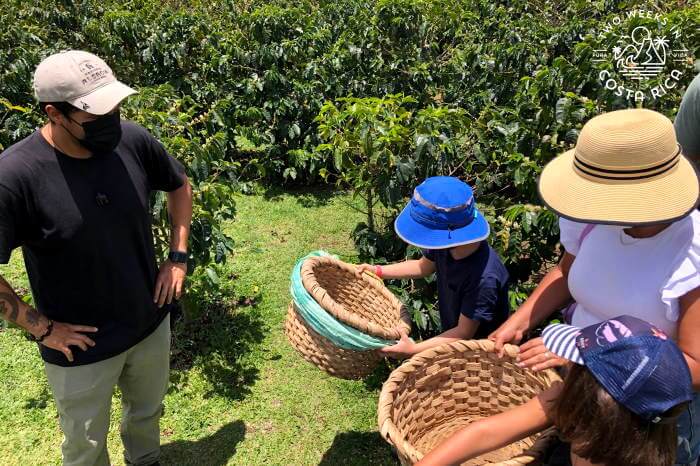
Of course, the baskets were nowhere near full at the end, but it was entertaining for us all.
Mario taught us about how the beans ripen, then took the opportunity to tell us about the real coffee pickers.
These workers, he told us, usually come from neighboring Nicaragua and Panama to pick coffee. They are paid by the volume of beans they collect, not by the hour.
The work is hard and sometimes dangerous, with snakes and spiders occasionally making homes in the coffee fields.
Coffee Research in Progress
After picking coffee cherries (ripe beans), we also got to see a few of the test varieties growing on the farm. Each one is numbered and monitored to see how it performs.
It was really interesting to see the coffee research in progress right before our eyes! Mario explained that there are over 500 varieties to crossbreed. Pollination is done all by hand.
Once a variety is proven to be viable, the seedlings are shared with Costa Rican farmers for free. Again, with no commitment to sell to Starbucks.

How Coffee is Processed
The next part of the tour was through some industrial equipment that is used to separate the beans, shell them, and wash them.
Though the machines weren’t working at the time of our visit (not harvest season), we learned all about the steps involved.
Even this part of the process was innovative. Mario explained how they made a few small changes to the traditional equipment to reduce the amount of water needed for processing.
Additionally, all the outer shells of the beans, he told us, are composted and made into fertilizer.
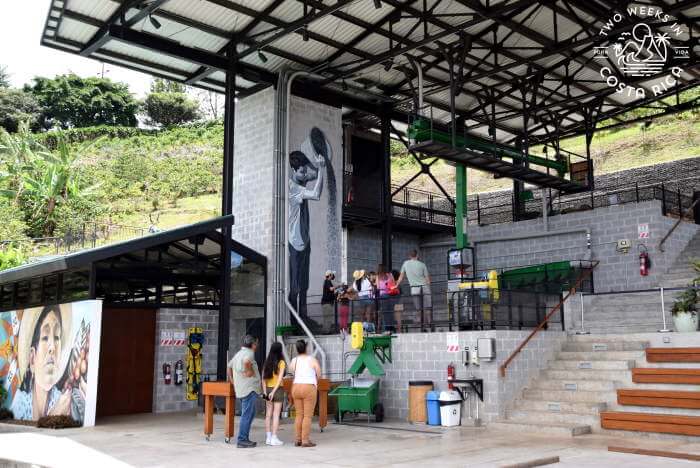
Enjoying a Cup
Our last stop was the tasting patio, just off the Starbucks restaurant. This overlooked the coffee fields and a small waterfall. It was the perfect setting to sip the final product.
Mario prepared a few different blends and explained the differences. We all sipped, compared, and enjoyed while taking in the scenery.
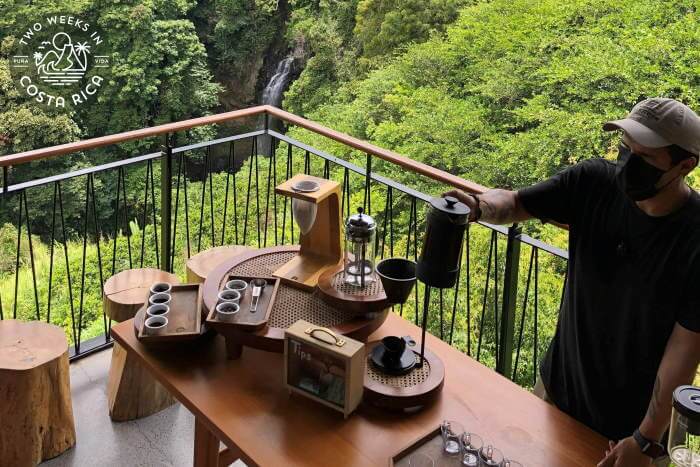
Planning a Visit to Starbucks Hacienda Alsacia
Location
Hacienda Alsacia, where the Starbucks coffee tour is located, is in San Luis, Sabanilla, Alajuela.
It is about one hour from downtown San Jose and 30 minutes from the SJO International Airport in Alajuela.
Accessibility
The facility at Hacienda Alsacia is handicap accessible. They have ramps and an elevator.
There is limited walking on the tour.
Tour Hours
Tours are 90 minutes and run daily from 8:00 a.m. to 4:00 p.m.
English tours start on the hour (e.g., 8:00 a.m., 9:00 a.m.).
Spanish tours start on the half hour (e.g., 8:30 a.m., 9:30 a.m.).

Buying Tickets & Ticket Costs
Tickets can be purchased online through the Starbucks website.
Tourists: Adults – $30, Seniors & Students (with ID) – $25
Nationals/Residents: Adults – $20, Seniors & Students (with ID) – $15
Children (6 and under) are free.
Cafe
If you’d like to just check out the cafe, it’s set up like a traditional Starbucks. You’ll find the usual sandwiches, snacks, and treats in display cases. They also have a drink menu with innovative coffee preparations, coffee flights, milkshakes, wine, and beer.
The cafe is open air and looks out to the beautiful green coffee plantation.
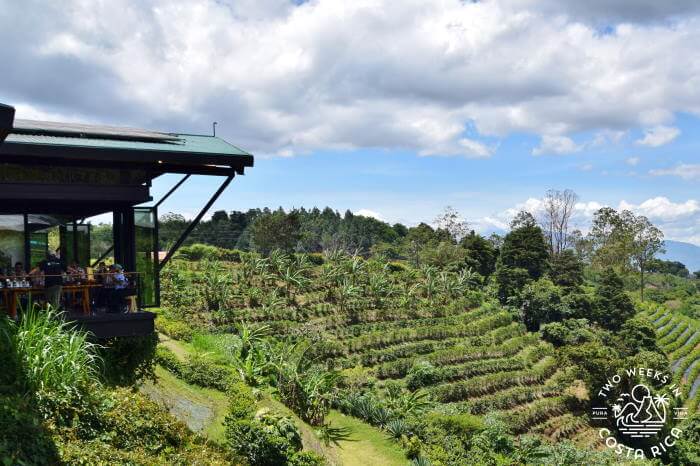
Parking
Free parking is available onsite. There was a guard watching the lot when we were there, but as always, never leave any valuables in your car, just in case.
Conclusion
We were first skeptical about how the Starbucks coffee tour could possibly compare to some other coffee tours we have done in Costa Rica with small farmers. But after visiting and learning about the important work being done to help the coffee community, we have a whole new appreciation for Starbucks.
While the tour was not traditional, it still covered the basics about how coffee is grown, processed, and enjoyed. All with a twist on how the coffee industry is changing and adapting for the future. We highly recommend a visit.
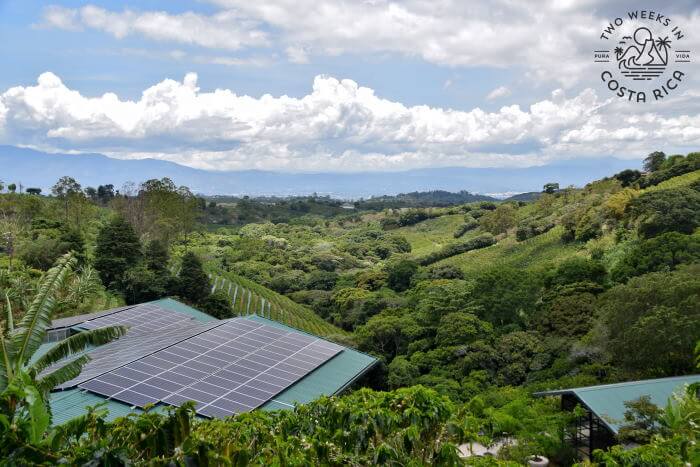
Have a question about the Starbucks Coffee Tour in Costa Rica? Ask us below.
Looking for more information to help you plan your trip? Check out these articles.
How to Spend 1 or 2 Days in San Jose, Costa Rica – If you are looking to explore Costa Rica’s cultural center, use this post for tips on the best museums, where to stay, and more.
The Truth About Visiting Poas Volcano – Not far from the Starbucks coffee tour is one of Costa Rica’s most visited volcanoes. But will you get lucky and see the crater?
La Paz Waterfall Gardens: Wildlife Up Close – Another common day trip from San Jose is La Paz Waterfall Gardens. Here you can see lots of Costa Rica’s diverse wildlife, at a close distance.

